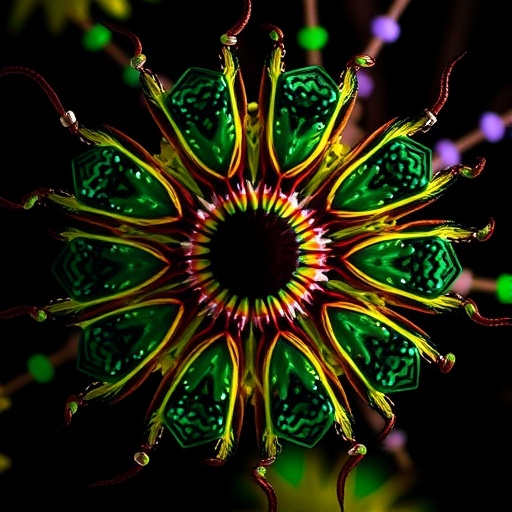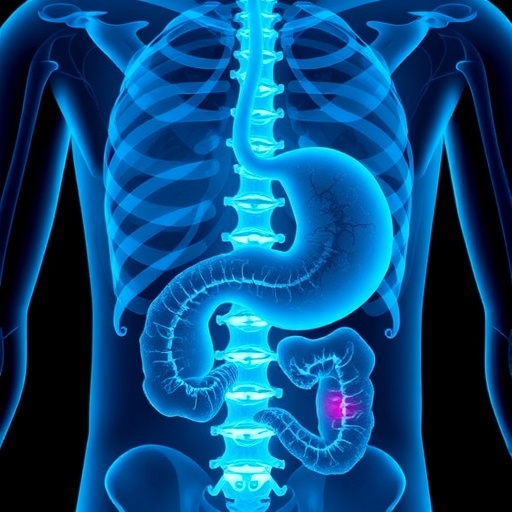In a groundbreaking leap for plant biochemistry and natural product biosynthesis, researchers at the Max Planck Institute for Chemical Ecology in Jena have identified a pivotal enzyme that completes our understanding of the iridoid biosynthetic pathway in plants. This enzyme, an iridoid cyclase, catalyzes the cyclisation of a key intermediate molecule to form nepetalactol—the fundamental iridoid scaffold that acts as the gateway to a plethora of bioactive natural products critical to agriculture, medicine, and plant defense. This discovery, published recently in Nature Plants, not only fills a long-standing gap in the biochemistry of these ancient terpene-derived compounds but also opens new horizons in biotechnological applications for drug production.
Iridoids represent a vast and evolutionarily conserved family of secondary metabolites found in thousands of plant species. Their biological significance stretches beyond plant ecology; they contribute to defense mechanisms against herbivores and pathogens and play roles in mutualistic plant interactions. Nutritionally, iridoids are components of everyday foods such as olives and blueberries, offering anti-inflammatory potential that has intrigued both nutritionists and pharmacologists alike. Medically, these compounds serve as precursors for clinically important alkaloids like vinblastine and vincristine, chemotherapeutic agents extensively used in cancer treatment.
Until now, the biosynthetic pathway leading to these iridoids had remained unfinished. While several enzymes involved in the initial steps were identified, the critical enzymatic process that orchestrates the cyclisation step forming nepetalactol had eluded scientists. This chemical transformation is complex, involving the formation of a ring structure from a linear precursor. Previous studies suggested this reaction might occur spontaneously without enzymatic assistance or might be facilitated by a yet unidentified enzyme. The uncertainty created a major bottleneck, impeding full metabolic engineering of the pathway for pharmaceutical production.
Sarah O’Connor, whose lab has dedicated over 15 years to decoding the intricacies of iridoid biosynthesis, elaborates on the challenge: “The iridoid synthases known to this point produced nepetalactol in low yields along with a multitude of unwanted by-products. This hinted that the cyclisation step was not efficiently catalyzed by these enzymes alone. We hypothesized there existed an additional cyclase enzyme, but its identity was unknown and difficult to pinpoint because it did not resemble any known cyclases or enzymes catalyzing similar reactions.”
A turning point was reached through a collaboration with Robin Buell’s group at the University of Georgia, who provided a sophisticated gene expression dataset derived from single-cell transcriptomics of ipecac plants, a species famed for its medicinal alkaloids. This data offered unprecedented precision by correlating the expression of hundreds of unknown genes within individual cells specialized in iridoid production. Cross-referencing with a previously available tissue-level expression dataset drastically narrowed the search to a handful of candidate genes.
The diligent efforts of graduate student Chloée Tymen enabled experimental validation of these candidates. Expressing these genes heterologously in plants and bacterial systems yielded promising results. One gene in particular stood out—its product demonstrated the elusive iridoid cyclase activity by efficiently catalyzing the cyclisation reaction to produce nepetalactol. This marked the first direct demonstration of an enzyme performing this crucial step in iridoid biosynthesis.
Perhaps most astonishing was the revelation that this cyclase enzyme belongs to a completely unexpected class of proteins, one previously characterized exclusively for catalyzing mechanistically distinct reactions. According to Maite Colinas, the study’s first author, “The functional versatility of this enzyme challenges traditional assumptions that enzyme classes are limited to specific reaction types. It underscores nature’s capacity for evolutionary innovation, whereby an enzyme adapts structurally and functionally to undertake entirely new catalytic roles.”
Despite this breakthrough, the exact mechanistic pathway by which the cyclase facilitates the ring closure remains to be elucidated. Multiple biochemical routes could theoretically yield nepetalactol, and pinpointing the precise mechanism will require detailed structural and kinetic studies. Unraveling this mystery may also shed light on the evolutionary trajectory of this enzyme from ancestral protein frameworks to its current specialized function.
This discovery holds profound potential for industrial biotechnology. With the cyclase enzyme identified, researchers can now reconstruct the complete iridoid pathway in heterologous hosts such as yeast, fungi, or alternative plants. Such bioengineering approaches promise sustainable, scalable production of valuable iridoid-derived pharmaceuticals, including anti-cancer drugs like vinblastine and vincristine, circumventing costly and low-yield extraction from native plant sources.
Furthermore, the finding compels a reassessment of metabolic pathway predictions derived solely from bioinformatics. The unexpected enzymatic function of this cyclase exemplifies how empirical biochemical investigations remain indispensable in revealing novel enzymatic activities and uncovering cryptic metabolic capabilities in plants.
The study also surveyed thousands of plant species using amino acid sequence databases, revealing that the newly identified cyclase is exclusive to species known to produce iridoids. This correlation further validates its essential role in the biosynthetic machinery and highlights evolutionary conservation. Species visualized in this research include well-known medicinal and ornamental plants such as Carapichea ipecacuanha (ipecac), Cinchona pubescens (fever tree), Allamanda cathartica (golden trumpet), Paulownia tomentosa (princess tree), Gelsemium sempervirens (Carolina jessamine), Catharanthus roseus (Madagascar periwinkle), Strychnos nux-vomica (strychnine tree), and Rauvolfia tetraphylla (devil pepper).
As research advances, the detailed knowledge of how this novel enzyme integrates into the broader metabolic network will enable innovation in synthetic biology and natural product chemistry. By combining enzymology, genomics, and chemical ecology, scientists are now poised to exploit iridoid pathways for creating novel therapeutics, enhancing crop resistance, and exploring evolutionary questions about enzyme function diversification.
This discovery represents a paradigm shift in our understanding of plant metabolic complexity and enzymatic adaptability. It reaffirms the importance of interdisciplinary collaboration and sophisticated omics technologies in unraveling the hidden biochemical treasures of nature. The ramifications for medicine and agriculture are profound, ensuring that this advance will resonate across scientific disciplines and industries worldwide.
Subject of Research: Not applicable
Article Title: Discovery of iridoid cyclase completes the iridoid pathway in asterids
News Publication Date: 3-Oct-2025
Web References:
Press release on iridoid biosynthesis: https://www.ice.mpg.de/495385/PR_Colinas
Press release on catnip biosynthesis: https://www.ice.mpg.de/345493/PR_Lichman
University of Georgia Buell Lab: https://buell-lab.github.io/robin.html
References:
DOI link to publication in Nature Plants: http://dx.doi.org/10.1038/s41477-025-02122-6
Image Credits:
Credit: Eva Rothe, greenhouse of the Max Planck Institute for Chemical Ecology (except the photo of the ipecac plant by Maite Colinas)
Keywords:
Iridoids, Iridoid cyclase, Nepetalactol, Plant secondary metabolites, Terpene biosynthesis, Enzymatic cyclisation, Natural product biosynthesis, Metabolic pathway, Cancer drugs, Vinblastine, Vincristine, Biotechnological production
Tags: applications in drug productionconnection to alkaloids in medicineevolution of plant biochemistryiridoid biosynthesis pathwayiridoids in agricultureiridoids in plant defenseMax Planck Institute research findingsnepetalactol productionnutritional benefits of iridoidsplant secondary metabolitesrole of iridoid cyclase enzymetherapeutic potential of iridoids





